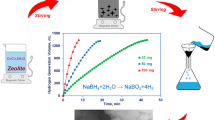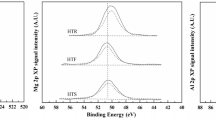Abstract
A carbon supported PtMo aqueous phase reforming catalyst for producing hydrogen from glycerol was characterized by analysis of the reaction products and pathway, TEM, XPS and XAS spectroscopy. Operando X-ray absorption spectroscopy (XAS) indicates the catalyst consists of bimetallic nano-particles with a Pt rich core and a Mo rich surface. XAS of adsorbed CO indicates that approximately 25% of the surface atoms are Pt. X-ray photoelectron spectroscopy indicates that there is unreduced and partially reduced Mo oxide (MoO3 and MoO2), and Pt-rich PtMo bimetallic nano-particles. The average size measured by transmission electron microscopy of the fresh PtMo nano-particles is about 2 nm, which increases in size to 5 nm after 30 days of glycerol reforming at 31 bar and 503 K. The catalyst structure differs from the most energetically stable structure predicted by density functional theory (DFT) calculations for metallic Pt and Mo atoms. However, DFT indicates that for nano-particles composed of metallic Pt and Mo oxide, the Mo oxide is at the particle surface. Subsequent reduction would lead to the experimentally observed structure. The aqueous phase reforming reaction products and intermediates are consistent with both C–C and C–OH bond cleavage to generate H2/CO2 or the side product CH4. While the H2 selectivity at low conversion is about 75%, cleavage of C–OH bonds leads to liquid products with saturated carbon atoms. At high conversions (to gas), these will produced additional CH4 reducing the H2 yield and selectivity.

















Similar content being viewed by others
References
Bridgwater AV, Peacocke GVC (2000) Fast pyrolysis processes for biomass. Renew Sustain Energy Rev 4:1–73
Huber GW, Iborra S, Corma A (2006) Synthesis of transportation fuels from biomass: chemistry, catalysts, and engineering. Chem Rev 106:4044–4098
Serrano-Ruiz JC, West RM, Dumesic JA (2010) Catalytic conversion of renewable biomass resources to fuels and chemicals. Annu Rev Chem Biomol Eng 1:79–100
Chheda JN, Huber GW, Dumesic JA (2007) Liquid-phase catalytic processing of biomass-derived oxygenated hydrocarbons to fuels and chemicals. Angew Chem Int Ed 46:7164–7183
Edward F (2000) Catalytic hydrodeoxygenation. Appl Catal A 199:147–190
Cortright RD, Davda RR, Dumesic JA (2002) Hydrogen from catalytic reforming of biomass-derived hydrocarbons in liquid water. Nature 418:964–967
Luo N, Zhao X, Cao F, Xiao T, Fang D (2007) Thermodynamic study on hydrogen generation from different glycerol reforming processes. Energy Fuels 21:3505–3512
Henao CA, Simonetti D, Dumesic JA, Maravelias CT (2009) Conversion of glycerol to liquid fuels. In: Rita Maria de Brito Alves Jr CAOdNaECB (ed) Computer aided chemical engineering. Elsevier, Amsterdam, pp 1719–1724
Kunkes EL, Simonetti DA, West RM, Serrano-Ruiz JC, Gärtner CA, Dumesic JA (2008) Catalytic conversion of biomass to monofunctional hydrocarbons and targeted liquid-fuel classes. Science 322:417–421
Soares RR, Simonetti DA, Dumesic JA (2006) Glycerol as a source for fuels and chemicals by low-temperature catalytic processing. Angew Chem Int Ed 45:3982–3985
Kunkes EL, Soares RR, Simonetti DA, Dumesic JA (2009) An integrated catalytic approach for the production of hydrogen by glycerol reforming coupled with water-gas shift. Appl Catal B 90:693–698
Shabaker JW, Huber GW, Davda RR, Cortright RD, Dumesic JA (2003) Aqueous-phase reforming of ethylene glycol over supported platinum catalysts. Catal Lett 88:1–8
King DL, Zhang L, Xia G, Karim AM, Heldebrant DJ, Wang X, Peterson T, Wang Y (2010) Aqueous phase reforming of glycerol for hydrogen production over Pt–Re supported on carbon. Appl Catal B 99:206–213
Fingland B, Ribeiro F, Miller J (2009) Simultaneous measurement of X-ray absorption spectra and kinetics: a fixed-bed, plug-flow operando reactor. Catal Lett 131:1–6
Doniach S, Sunjic M (1970) Many-electron singularity in x-ray photoemission and x-ray line spectra from metals. J Phys C 3:285–291
Shirley DA (1972) High-resolution X-ray photoemission spectrum of the valence bands of gold. Phys Rev B 5:4709
Ansell RO, Dickinson T, Povey AF, Sherwood PMA (1979) X-ray photoelectron spectroscopic studies of electrode surfaces using a new controlled transfer technique: Part II. Results for a molybdenum electrode and the curve fitting procedure. J Electroanal Chem Interfacial Electrochem 98:79–89
Perdew JP, Wang Y (1992) Accurate and simple analytic representation of the electron-gas correlation energy. Phys Rev B 45:13244
Perdew JP, Chevary JA, Vosko SH, Jackson KA, Pederson MR, Singh DJ, Fiolhais C (1992) Atoms, molecules, solids, and surfaces: applications of the generalized gradient approximation for exchange and correlation. Phys Rev B 46:6671
Valiev M, Bylaska EJ, Govind N, Kowalski K, Straatsma TP, Van Dam HJJ, Wang D, Nieplocha J, Apra E, Windus TL, de Jong WA (2010) NWChem: a comprehensive and scalable open-source solution for large scale molecular simulations. Comput Phys Commun 181:1477–1489
Jellinek J, Sumer A (in preparation)
Shabaker JW, Davda RR, Huber GW, Cortright RD, Dumesic JA (2003) Aqueous-phase reforming of methanol and ethylene glycol over alumina-supported platinum catalysts. J Catal 215:344–352
Guo N, Fingland BR, Williams WD, Kispersky VF, Jelic J, Delgass WN, Ribeiro FH, Meyer RJ, Miller JT (2010) Determination of CO, H2O and H2 coverage by XANES and EXAFS on Pt and Au during water gas shift reaction. Phys Chem Chem Phys 12:5678–5693
Choi JG, Thompson LT (1996) XPS study of as-prepared and reduced molybdenum oxides. Appl Surf Sci 93:143–149
Grgur BN, Markovic NM, Ross PN (1998) Electrooxidation of H2, CO, and H2/CO mixtures on a well-characterized Pt70Mo30 bulk alloy electrode. J Phys Chem B 102:2494–2501
Neophytides SG, Zafeiratos SH, Jaksic MM (2003) Selective interactive grafting of composite bifunctional electrocatalysts for simultaneous anodic hydrogen and CO oxidation. J Electrochem Soc 150:E512–E526
Getman RB, Schneider WF, Smeltz AD, Delgass WN, Ribeiro FH (2009) Oxygen-coverage effects on molecular dissociations at a Pt metal surface. Phys Rev Lett 102:076101
Ferrando R, Jellinek J, Johnston RL (2008) Nanoalloys: from theory to applications of alloy clusters and nanoparticles. Chem Rev 108:845–910
Jellinek J, Krissinel EB (1996) NinAlm alloy clusters: analysis of structural forms and their energy ordering. Chem Phys Lett 258:283–292
Jellinek J (2008) Nanoalloys: tuning properties and characteristics through size and composition. Faraday Discuss 138:11–35
Chia M, Pagaán-Torres YJ, Hibbitts D, Tan Q, Pham HN, Datye AK, Neurock M, Davis RJ, Dumesic JA (2011) Selective hydrogenolysis of polyols and cyclic ethers over bifunctional surface sites on rhodium–rhenium catalysts. J Am Chem Soc 133:12675–12689
Gursahani KI, Alcalá R, Cortright RD, Dumesic JA (2001) Reaction kinetics measurements and analysis of reaction pathways for conversions of acetic acid, ethanol, and ethyl acetate over silica-supported Pt. Appl Catal A 222:369–392
Salciccioli M, Yu W, Barteau MA, Chen JG, Vlachos DG (2011) Differentiation of O–H and C–H bond scission mechanisms of ethylene glycol on Pt and Ni/Pt using theory and isotopic labeling experiments. J Am Chem Soc 133:7996–8004
Simonetti DA, Kunkes EL, Dumesic JA (2007) Gas-phase conversion of glycerol to synthesis gas over carbon-supported platinum and platinum–rhenium catalysts. J Catal 247:298–306
Loock H-P, Simard B, Wallin S, Linton C (1998) Ionization potentials and bond energies of TiO, ZrO, NbO, and MoO. J Chem Phys 109:8980–8992
Davda RR, Shabaker JW, Huber GW, Cortright RD, Dumesic JA (2005) A review of catalytic issues and process conditions for renewable hydrogen and alkanes by aqueous-phase reforming of oxygenated hydrocarbons over supported metal catalysts. Appl Catal B 56:171–186
Kunkes EL, Simonetti DA, Dumesic JA, Pyrz WD, Murillo LE, Chen JG, Buttrey DJ (2008) The role of rhenium in the conversion of glycerol to synthesis gas over carbon supported platinum–rhenium catalysts. J Catal 260:164–177
Acknowledgments
This material is based upon work supported as part of the Institute for Atom-efficient Chemical Transformations (IACT), an Energy Frontier Research Center funded by the U.S. Department of Energy, Office of Science, Office of Basic Energy Sciences. Use of the Advanced Photon Source is supported by the U. S. Department of Energy, Office of Science, and Office of Basic Energy Sciences, under Contract DE-AC02-06CH11357. MRCAT operations are supported by the Department of Energy and the MRCAT member institutions. J.J. was also supported by the Office of Basic Energy Sciences, Division of Chemical Sciences, Geosciences and Biosciences, U.S. Department of Energy under Contract No. DE-AC02-06CH11357. This research used the resources of the National Energy Research Scientific Computing Center (NERSC), which is supported by the Office of Science of the U.S. Department of Energy under Contract No. DE-AC02-05CH11231 and of the Laboratory Computing Resource Center (Fusion/LCRC) at Argonne National Laboratory. EAS acknowledges support the U.S. Department of Energy, Office of Basic Energy Sciences, under Contract No. DE-AC02-98CH10886.
Author information
Authors and Affiliations
Corresponding authors
Rights and permissions
About this article
Cite this article
Dietrich, P.J., Lobo-Lapidus, R.J., Wu, T. et al. Aqueous Phase Glycerol Reforming by PtMo Bimetallic Nano-Particle Catalyst: Product Selectivity and Structural Characterization. Top Catal 55, 53–69 (2012). https://doi.org/10.1007/s11244-012-9775-5
Published:
Issue Date:
DOI: https://doi.org/10.1007/s11244-012-9775-5




